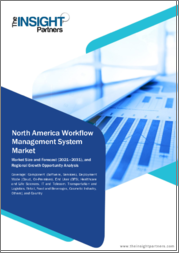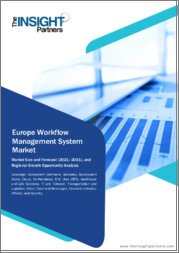
|
시장보고서
상품코드
1541510
워크플로우 관리 시스템 시장 보고서 : 구성요소별, 전개 방식별, 산업별, 지역별(2024-2032년)Workflow Management System Market Report by Component, Deployment Type, Vertical, and Region 2024-2032 |
||||||
세계 워크플로우 관리 시스템 시장 규모는 2023년 98억 달러에 달했습니다. 향후 IMARC Group은 2032년까지 시장 규모가 130억 달러에 달해 2024-2032년 사이 3.1%의 연평균 성장률(CAGR)을 기록할 것으로 예측했습니다.
인력관리(WFM)는 조직이 인력 활용에 대한 데이터를 모니터링하고 중앙에서 관리할 수 있도록 지원하는 도구와 프로세스의 집합체를 말합니다. 여기에는 일선 감독자, 경영자, 관리자 및 조직 전체 근로자의 효율성을 높이기 위한 다양한 성과 기반 소프트웨어 및 도구가 포함됩니다. 인력 예측 및 스케줄링, 인사 관리, 인력 분석 등 여러 기능을 수행할 수 있습니다. 또한 전반적인 생산성을 높이고 의사결정을 보다 효율적으로 할 수 있는 맞춤형 워크플로우를 생성할 수 있습니다. 따라서 은행, 금융 서비스, 보험(BFSI), 의료, 운송 및 물류, 에너지, 소매, 정보기술(IT) 및 통신 등 다양한 산업에서 폭넓게 활용되고 있습니다.
클라우드 기반 솔루션의 채택 증가와 함께 업계 전반의 자동화 요구가 증가함에 따라 시장 성장을 촉진하는 주요 요인 중 하나가 되고 있습니다. 인력 최적화에 대한 관심이 높아지면서 기업들은 시간을 관리하고 중복 작업을 피하기 위해 WFM 솔루션을 광범위하게 채택하고 있습니다. 또한, 클라우드 기반 솔루션은 물리적 하드웨어 요구 사항을 최소화하기 때문에 조직에서 이러한 솔루션의 채택을 촉진하고 있습니다. 이 플랫폼은 또한 전체 운영 비용을 절감하고 다양한 엔드포인트에 대한 액세스를 제공하여 인프라의 확장성을 높입니다. 또한, 스마트폰의 확산과 BYOD(Bring-Your-Own-Devices) 트렌드도 시장 성장에 긍정적인 영향을 미치고 있으며, WFM 솔루션의 도입으로 고용주는 언제든지 작업 진행 상황을 파악할 수 있고, 직원들은 공식적인 파일에 대한 안전한 액세스를 제공할 수 있습니다. 다른 요인으로는 특히 신흥 경제국의 급속한 도시화, WFM의 이점에 대한 인식 증가, IT 부문의 광범위한 연구 개발(R&D) 활동 등이 시장을 더욱 견인할 것으로 예상됩니다.
본 보고서에서 다루는 주요 질문들
- 2023년 워크플로우 관리 시스템 시장 세계 시장 규모는?
- 2024-2032년 워크플로우 관리 시스템 시장 세계 시장 예측 성장률은?
- 세계 워크플로우 관리 시스템 시장을 이끄는 주요 요인은 무엇인가?
- COVID-19가 세계 워크플로우 관리 시스템 시장에 미치는 영향은?
- 세계 워크플로우 관리 시스템 시장의 구성요소별 시장 현황은?
- 세계 워크플로우 관리 시스템 시장의 전개 유형별 현황은?
- 워크플로우 관리 시스템 시장의 업종별 분류는?
- 세계 워크플로우 관리 시스템 시장의 주요 지역은?
- 세계 워크플로우 관리 시스템 시장의 주요 진출 기업은?
목차
제1장 서문
제2장 조사 범위와 조사 방법
- 조사 목적
- 이해관계자
- 데이터 소스
- 1차 정보
- 2차 정보
- 시장 추정
- 상향식 접근
- 하향식 접근
- 조사 방법
제3장 주요 요약
제4장 소개
- 개요
- 주요 업계 동향
제5장 세계의 워크플로우 관리 시스템 시장
- 시장 개요
- 시장 실적
- COVID-19의 영향
- 시장 예측
제6장 시장 내역 : 구성요소별
- 소프트웨어
- 서비스
제7장 시장 내역 : 전개 방식별
- 클라우드 기반
- 온프레미스
제8장 시장 내역 : 업계별
- BFSI
- 의료
- 에너지
- 소매
- IT와 통신
- 운송·물류
- 교육
- 기타
제9장 시장 내역 : 지역별
- 북미
- 미국
- 캐나다
- 아시아태평양
- 중국
- 일본
- 인도
- 한국
- 호주
- 인도네시아
- 기타
- 유럽
- 독일
- 프랑스
- 영국
- 이탈리아
- 스페인
- 러시아
- 기타
- 라틴아메리카
- 브라질
- 멕시코
- 기타
- 중동 및 아프리카
- 시장 동향
- 시장 내역 : 국가별
- 시장 예측
제10장 SWOT 분석
- 개요
- 강점
- 약점
- 기회
- 위협
제11장 밸류체인 분석
제12장 Porter's Five Forces 분석
- 개요
- 구매자의 교섭력
- 공급 기업의 교섭력
- 경쟁 정도
- 신규 참여업체의 위협
- 대체품의 위협
제13장 가격 분석
제14장 경쟁 상황
- 시장 구조
- 주요 기업
- 주요 기업 개요
- Appian Corporation Inc.
- Bizagi Group Limited
- IBM Corporation
- Newgen Software Technologies Ltd
- Nintex Global Ltd
- Oracle Corporation
- Pegasystems Inc.
- Software AG
- Xerox Holdings Corporation
The global workflow management system market size reached US$ 9.8 Billion in 2023. Looking forward, IMARC Group expects the market to reach US$ 13.0 Billion by 2032, exhibiting a growth rate (CAGR) of 3.1% during 2024-2032.
Workforce management (WFM) refers to a collection of tools and processes that enables an organization to monitor and centralize the data for their human resource utilization. It includes various performance-based software and tools to enhance the efficiencies of front-line supervisors, corporate management, managers and workers across the organization. It can perform multiple functions, such as workforce forecast and scheduling, HR management and workforce analysis. It can also create customized workflows that enhance overall productivity and make decision-making more efficient. Owing to this, it finds extensive applications across various industries, including banking, financial services, and insurance (BFSI), healthcare, transportation and logistics, energy, retail and information technology (IT) and telecom.
The growing need for automation across industries, along with the increasing adoption of cloud-based solutions, represents one of the key factors driving the growth of the market. With an increasing focus on workforce optimization, organizations are extensively employing WFM solutions to manage time and avoid duplication of tasks. Furthermore, cloud-based solutions minimize the requirements for physical hardware, which is also boosting the adoption of these solutions in organizations. The platform also reduces the overall operational costs and enhances the scalability of the infrastructure by providing access to various endpoints. Additionally, increasing penetration of smartphones, along with the prevailing trend of Bring-Your-Own-Devices (BYOD), is also creating a positive impact on the market growth. With the deployment of WFM solutions, the employer can track the progress on tasks at any point of time while providing the employees with secure access to official files. Other factors, including rapid urbanization, especially in developing economies, rising awareness about the benefits of WFM, and extensive research and development (R&D) activities in the field of IT, are expected to drive the market further.
Key Market Segmentation:
IMARC Group provides an analysis of the key trends in each sub-segment of the global workflow management system market report, along with forecasts at the global, regional and country level from 2024-2032. Our report has categorized the market based on component, deployment type and vertical.
Breakup by Component:
Software
Services
Breakup by Deployment Type:
Cloud-Based
On-Premises
Breakup by Vertical:
BFSI
Healthcare
Energy
Retail
IT and Telecom
Transportation and Logistics
Education
Others
Breakup by Region:
North America
United States
Canada
Asia-Pacific
China
Japan
India
South Korea
Australia
Indonesia
Others
Europe
Germany
France
United Kingdom
Italy
Spain
Russia
Others
Latin America
Brazil
Mexico
Others
Middle East and Africa
Competitive Landscape:
The competitive landscape of the industry has also been examined along with the profiles of the key players being Appian Corporation Inc., Bizagi Group Limited, IBM Corporation, Newgen Software Technologies Ltd, Nintex Global Ltd., Oracle Corporation, Pegasystems Inc., Software AG, and Xerox Holdings Corporation.
Key Questions Answered in This Report
- 1. What was the size of the global workflow management system market in 2023?
- 2. What is the expected growth rate of the global workflow management system market during 2024-2032?
- 3. What are the key factors driving the global workflow management system market?
- 4. What has been the impact of COVID-19 on the global workflow management system market?
- 5. What is the breakup of the global workflow management system market based on the component?
- 6. What is the breakup of the global workflow management system market based on the deployment type?
- 7. What is the breakup of the global workflow management system market based on vertical?
- 8. What are the key regions in the global workflow management system market?
- 9. Who are the key players/companies in the global workflow management system market?
Table of Contents
1 Preface
2 Scope and Methodology
- 2.1 Objectives of the Study
- 2.2 Stakeholders
- 2.3 Data Sources
- 2.3.1 Primary Sources
- 2.3.2 Secondary Sources
- 2.4 Market Estimation
- 2.4.1 Bottom-Up Approach
- 2.4.2 Top-Down Approach
- 2.5 Forecasting Methodology
3 Executive Summary
4 Introduction
- 4.1 Overview
- 4.2 Key Industry Trends
5 Global Workflow Management System Market
- 5.1 Market Overview
- 5.2 Market Performance
- 5.3 Impact of COVID-19
- 5.4 Market Forecast
6 Market Breakup by Component
- 6.1 Software
- 6.1.1 Market Trends
- 6.1.2 Market Forecast
- 6.2 Services
- 6.2.1 Market Trends
- 6.2.2 Market Forecast
7 Market Breakup by Deployment Type
- 7.1 Cloud-Based
- 7.1.1 Market Trends
- 7.1.2 Market Forecast
- 7.2 On-Premises
- 7.2.1 Market Trends
- 7.2.2 Market Forecast
8 Market Breakup by Vertical
- 8.1 BFSI
- 8.1.1 Market Trends
- 8.1.2 Market Forecast
- 8.2 Healthcare
- 8.2.1 Market Trends
- 8.2.2 Market Forecast
- 8.3 Energy
- 8.3.1 Market Trends
- 8.3.2 Market Forecast
- 8.4 Retail
- 8.4.1 Market Trends
- 8.4.2 Market Forecast
- 8.5 IT and Telecom
- 8.5.1 Market Trends
- 8.5.2 Market Forecast
- 8.6 Transportation and Logistics
- 8.6.1 Market Trends
- 8.6.2 Market Forecast
- 8.7 Education
- 8.7.1 Market Trends
- 8.7.2 Market Forecast
- 8.8 Others
- 8.8.1 Market Trends
- 8.8.2 Market Forecast
9 Market Breakup by Region
- 9.1 North America
- 9.1.1 United States
- 9.1.1.1 Market Trends
- 9.1.1.2 Market Forecast
- 9.1.2 Canada
- 9.1.2.1 Market Trends
- 9.1.2.2 Market Forecast
- 9.1.1 United States
- 9.2 Asia-Pacific
- 9.2.1 China
- 9.2.1.1 Market Trends
- 9.2.1.2 Market Forecast
- 9.2.2 Japan
- 9.2.2.1 Market Trends
- 9.2.2.2 Market Forecast
- 9.2.3 India
- 9.2.3.1 Market Trends
- 9.2.3.2 Market Forecast
- 9.2.4 South Korea
- 9.2.4.1 Market Trends
- 9.2.4.2 Market Forecast
- 9.2.5 Australia
- 9.2.5.1 Market Trends
- 9.2.5.2 Market Forecast
- 9.2.6 Indonesia
- 9.2.6.1 Market Trends
- 9.2.6.2 Market Forecast
- 9.2.7 Others
- 9.2.7.1 Market Trends
- 9.2.7.2 Market Forecast
- 9.2.1 China
- 9.3 Europe
- 9.3.1 Germany
- 9.3.1.1 Market Trends
- 9.3.1.2 Market Forecast
- 9.3.2 France
- 9.3.2.1 Market Trends
- 9.3.2.2 Market Forecast
- 9.3.3 United Kingdom
- 9.3.3.1 Market Trends
- 9.3.3.2 Market Forecast
- 9.3.4 Italy
- 9.3.4.1 Market Trends
- 9.3.4.2 Market Forecast
- 9.3.5 Spain
- 9.3.5.1 Market Trends
- 9.3.5.2 Market Forecast
- 9.3.6 Russia
- 9.3.6.1 Market Trends
- 9.3.6.2 Market Forecast
- 9.3.7 Others
- 9.3.7.1 Market Trends
- 9.3.7.2 Market Forecast
- 9.3.1 Germany
- 9.4 Latin America
- 9.4.1 Brazil
- 9.4.1.1 Market Trends
- 9.4.1.2 Market Forecast
- 9.4.2 Mexico
- 9.4.2.1 Market Trends
- 9.4.2.2 Market Forecast
- 9.4.3 Others
- 9.4.3.1 Market Trends
- 9.4.3.2 Market Forecast
- 9.4.1 Brazil
- 9.5 Middle East and Africa
- 9.5.1 Market Trends
- 9.5.2 Market Breakup by Country
- 9.5.3 Market Forecast
10 SWOT Analysis
- 10.1 Overview
- 10.2 Strengths
- 10.3 Weaknesses
- 10.4 Opportunities
- 10.5 Threats
11 Value Chain Analysis
12 Porters Five Forces Analysis
- 12.1 Overview
- 12.2 Bargaining Power of Buyers
- 12.3 Bargaining Power of Suppliers
- 12.4 Degree of Competition
- 12.5 Threat of New Entrants
- 12.6 Threat of Substitutes
13 Price Analysis
14 Competitive Landscape
- 14.1 Market Structure
- 14.2 Key Players
- 14.3 Profiles of Key Players
- 14.3.1 Appian Corporation Inc.
- 14.3.1.1 Company Overview
- 14.3.1.2 Product Portfolio
- 14.3.1.3 Financials
- 14.3.2 Bizagi Group Limited
- 14.3.2.1 Company Overview
- 14.3.2.2 Product Portfolio
- 14.3.2.3 Financials
- 14.3.3 IBM Corporation
- 14.3.3.1 Company Overview
- 14.3.3.2 Product Portfolio
- 14.3.3.3 Financials
- 14.3.3.4 SWOT Analysis
- 14.3.4 Newgen Software Technologies Ltd
- 14.3.4.1 Company Overview
- 14.3.4.2 Product Portfolio
- 14.3.4.3 Financials
- 14.3.5 Nintex Global Ltd
- 14.3.5.1 Company Overview
- 14.3.5.2 Product Portfolio
- 14.3.5.3 Financials
- 14.3.6 Oracle Corporation
- 14.3.6.1 Company Overview
- 14.3.6.2 Product Portfolio
- 14.3.6.3 Financials
- 14.3.6.4 SWOT Analysis
- 14.3.7 Pegasystems Inc.
- 14.3.7.1 Company Overview
- 14.3.7.2 Product Portfolio
- 14.3.7.3 Financials
- 14.3.7.4 SWOT Analysis
- 14.3.8 Software AG
- 14.3.8.1 Company Overview
- 14.3.8.2 Product Portfolio
- 14.3.8.3 Financials
- 14.3.9 Xerox Holdings Corporation
- 14.3.9.1 Company Overview
- 14.3.9.2 Product Portfolio
- 14.3.9.3 Financials
- 14.3.9.4 SWOT Analysis
- 14.3.1 Appian Corporation Inc.



















